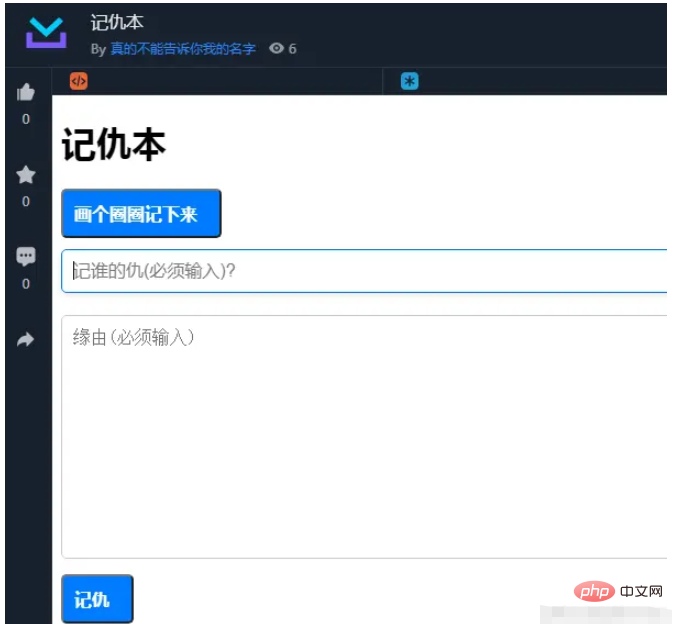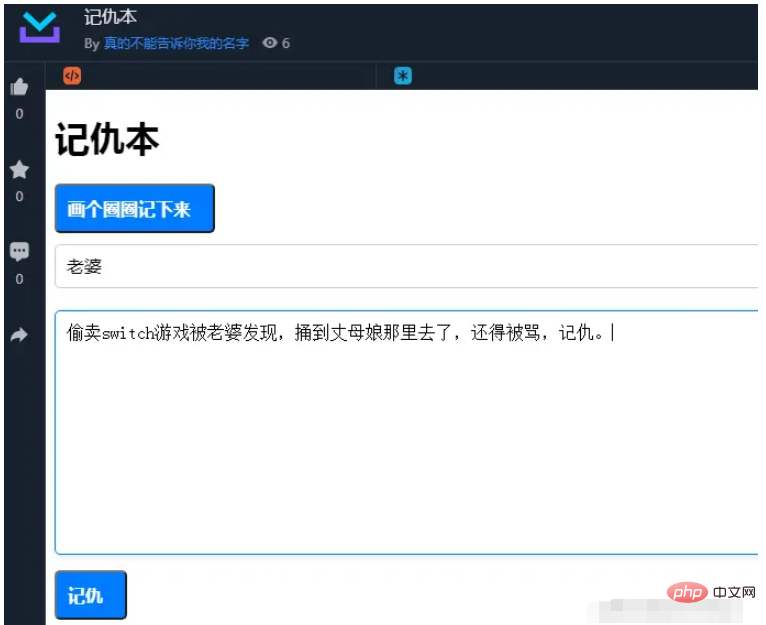How to write an interesting grudge book in Python
KEEPING BEN SHOW
As mentioned in the title, the project has been written and is based on local_storageThe project stored locally
The project runtime is based on brython, You may want to ask, why not use native python to write web pages. There is a misunderstanding that web pages are written by html code, and nativepythonIt is very difficult to operate DOM, so brython is designed for this purpose.
When you initially open the page, there is only one Add button because there is no data display.

When we click the [Draw a circle and write it down] button, it will refresh to a new page, for example:

At this point, we only need to enter information, such as recording a grudge against our wife. If we reveal the reason for buying a switch game to our mother-in-law, we will be scolded.

At this point, click Hold a Grudge and it will be stored on the page.

If you click Forgiven at this time, you can delete the record.
brython's local_storage
You may have noticed carefully, hey, if you close the browser and open it next time, why is there still a record on it? This is because of the use of local_storage, so, what is local_storage?
Hey, we are using local_storage in brython, but it is not defined by python, but HTML 5 is one of the APIs for storing data, which can maintain key-value pair data blocks in the browser.
Now let’s show the storage and deletion operations using brython.
Import library:
from browser.local_storage import storage
Storage data, such as key value information juejinName is stored as pdudo
storage[juejinName] = "pdudo"
If you query, directly Just use storage[variable], if it is empty, it will return None
v = storage[juejinName]
to loop through all key, you need to introduce window library, and then use for...in to complete
from browser import window
for key in window.localStorage:
print(key), or you can directly use for...in to traverse storage
What about deleting data? Just delete the dictionary
del storage[juejinName]
storageIs the operation very similar to the dictionary? Reduces developers’ learning costs.
Production project
After we have the above prerequisites, we can look at the project again and it can be summarized as an addition and deletion check for localStorage. First, when the page is loaded time, we need to first traverse the localstorage data to map it to a table, for example:
for key in window.localStorage:
tr = html.TR()
datas = json.loads(storage[key])
delBtn = html.BUTTON("已原谅")
delBtn.dataset["id"] = datas["id"]
delBtn.className = "confirm-btn"
delBtn.bind("click",delGrudges)
td = html.TD(delBtn+" "+time.strftime('%Y-%m-%d %H:%M:%S', time.localtime(int(datas["id"]))))
tr <= td
for tdVal in datas["whos"],datas["Text"]:
td = html.TD(tdVal)
tr <= td
tb <= tr
userWindows <= tbThe above code traverses localStorage, and then After defining the delete button, after combining other values, load them all into table, and then display them on the page.
What about adding data?
def saveGrudges(ev):
getWhoVal = document["whos"].value
getTextVal = document["textArea"].value
if getWhoVal == "" or getTextVal == "":
return
document["saveBtn"].unbind("click")
ids = int(time.time())
datas = {
"id": ids,
"whos": getWhoVal,
"Text": getTextVal
}
storage[str(ids)] = json.dumps(datas)The above code displays the values in the input and textarea boxes, and then determines whether the user has not input. We assemble the data into a dictionary and then convert it to String, and then store it in localstage.
There are other operations. You can directly read the code description for this. brythonIt's very simple.
The above is the detailed content of How to write an interesting grudge book in Python. For more information, please follow other related articles on the PHP Chinese website!

Hot AI Tools

Undresser.AI Undress
AI-powered app for creating realistic nude photos

AI Clothes Remover
Online AI tool for removing clothes from photos.

Undress AI Tool
Undress images for free

Clothoff.io
AI clothes remover

Video Face Swap
Swap faces in any video effortlessly with our completely free AI face swap tool!

Hot Article

Hot Tools

Notepad++7.3.1
Easy-to-use and free code editor

SublimeText3 Chinese version
Chinese version, very easy to use

Zend Studio 13.0.1
Powerful PHP integrated development environment

Dreamweaver CS6
Visual web development tools

SublimeText3 Mac version
God-level code editing software (SublimeText3)

Hot Topics
 PHP and Python: Different Paradigms Explained
Apr 18, 2025 am 12:26 AM
PHP and Python: Different Paradigms Explained
Apr 18, 2025 am 12:26 AM
PHP is mainly procedural programming, but also supports object-oriented programming (OOP); Python supports a variety of paradigms, including OOP, functional and procedural programming. PHP is suitable for web development, and Python is suitable for a variety of applications such as data analysis and machine learning.
 Choosing Between PHP and Python: A Guide
Apr 18, 2025 am 12:24 AM
Choosing Between PHP and Python: A Guide
Apr 18, 2025 am 12:24 AM
PHP is suitable for web development and rapid prototyping, and Python is suitable for data science and machine learning. 1.PHP is used for dynamic web development, with simple syntax and suitable for rapid development. 2. Python has concise syntax, is suitable for multiple fields, and has a strong library ecosystem.
 Python vs. JavaScript: The Learning Curve and Ease of Use
Apr 16, 2025 am 12:12 AM
Python vs. JavaScript: The Learning Curve and Ease of Use
Apr 16, 2025 am 12:12 AM
Python is more suitable for beginners, with a smooth learning curve and concise syntax; JavaScript is suitable for front-end development, with a steep learning curve and flexible syntax. 1. Python syntax is intuitive and suitable for data science and back-end development. 2. JavaScript is flexible and widely used in front-end and server-side programming.
 PHP and Python: A Deep Dive into Their History
Apr 18, 2025 am 12:25 AM
PHP and Python: A Deep Dive into Their History
Apr 18, 2025 am 12:25 AM
PHP originated in 1994 and was developed by RasmusLerdorf. It was originally used to track website visitors and gradually evolved into a server-side scripting language and was widely used in web development. Python was developed by Guidovan Rossum in the late 1980s and was first released in 1991. It emphasizes code readability and simplicity, and is suitable for scientific computing, data analysis and other fields.
 Can vs code run in Windows 8
Apr 15, 2025 pm 07:24 PM
Can vs code run in Windows 8
Apr 15, 2025 pm 07:24 PM
VS Code can run on Windows 8, but the experience may not be great. First make sure the system has been updated to the latest patch, then download the VS Code installation package that matches the system architecture and install it as prompted. After installation, be aware that some extensions may be incompatible with Windows 8 and need to look for alternative extensions or use newer Windows systems in a virtual machine. Install the necessary extensions to check whether they work properly. Although VS Code is feasible on Windows 8, it is recommended to upgrade to a newer Windows system for a better development experience and security.
 Can visual studio code be used in python
Apr 15, 2025 pm 08:18 PM
Can visual studio code be used in python
Apr 15, 2025 pm 08:18 PM
VS Code can be used to write Python and provides many features that make it an ideal tool for developing Python applications. It allows users to: install Python extensions to get functions such as code completion, syntax highlighting, and debugging. Use the debugger to track code step by step, find and fix errors. Integrate Git for version control. Use code formatting tools to maintain code consistency. Use the Linting tool to spot potential problems ahead of time.
 How to run python with notepad
Apr 16, 2025 pm 07:33 PM
How to run python with notepad
Apr 16, 2025 pm 07:33 PM
Running Python code in Notepad requires the Python executable and NppExec plug-in to be installed. After installing Python and adding PATH to it, configure the command "python" and the parameter "{CURRENT_DIRECTORY}{FILE_NAME}" in the NppExec plug-in to run Python code in Notepad through the shortcut key "F6".
 How to run programs in terminal vscode
Apr 15, 2025 pm 06:42 PM
How to run programs in terminal vscode
Apr 15, 2025 pm 06:42 PM
In VS Code, you can run the program in the terminal through the following steps: Prepare the code and open the integrated terminal to ensure that the code directory is consistent with the terminal working directory. Select the run command according to the programming language (such as Python's python your_file_name.py) to check whether it runs successfully and resolve errors. Use the debugger to improve debugging efficiency.






